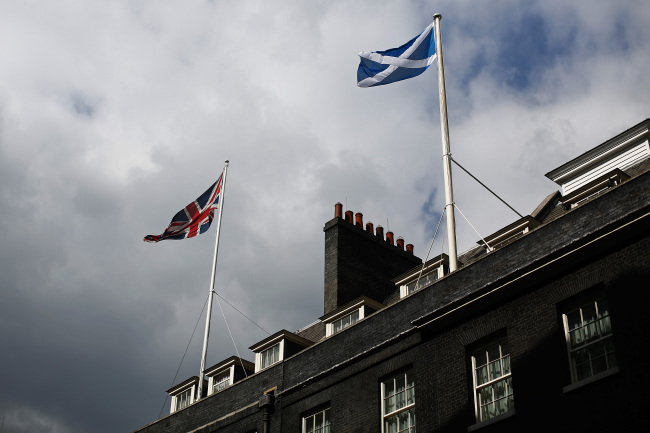[Newsmaker] Scotland and England: A tale of rivalry
By Korea HeraldPublished : Sept. 11, 2014 - 21:14
LONDON (AFP) ― The love-hate relationship between England and Scotland has been marked by bloodthirsty mediaeval battles, royal marriages and executions, followed by centuries of political and social unity.
While Scots prepare to vote on the 300-year-old merger with England, the history binding their fortunes goes back way before they even existed as recognizable nations.
Much of Scotland’s national story has been defined by its relationship with its bigger neighbor.
And whatever happens in next week’s referendum, Scotland and England will still sit wedged together on the same island, and Scotland’s fortunes will still be directly affected by its cross-border ties.
The Romans began constructing a border in the year 122. Hadrian’s Wall, which still exists in part, marked the empire’s northern frontier and was a defensive measure against the Caledonian tribes beyond.
While Scots prepare to vote on the 300-year-old merger with England, the history binding their fortunes goes back way before they even existed as recognizable nations.
Much of Scotland’s national story has been defined by its relationship with its bigger neighbor.
And whatever happens in next week’s referendum, Scotland and England will still sit wedged together on the same island, and Scotland’s fortunes will still be directly affected by its cross-border ties.
The Romans began constructing a border in the year 122. Hadrian’s Wall, which still exists in part, marked the empire’s northern frontier and was a defensive measure against the Caledonian tribes beyond.

Faced with Norse domination, the Picts and Scoti were united under Kenneth MacAlpin, considered the first king of Scots, who died in 858.
But when the succession of his dynasty fell into question and England’s king Edward I was invited to arbitrate, he claimed suzerainty, invaded in 1296 and earned himself the nickname Hammer of the Scots.
The Wars of Scottish Independence lasted until 1357, though king Robert the Bruce had effectively established independence by defeating the English forces at Bannockburn in 1314.
The battles against the English helped define Scotland’s sense of nationhood, and revelry in getting one over the “Auld Enemy” continues to this day.
“Flower of Scotland,” the 1967 song by folk band The Corries that is used by Scottish sports teams as a national anthem, centers on the patriotism of those who “stood against him; proud Edward’s army; and sent him homeward; tae think again.”
The 1502 Treaty of Perpetual Peace, signed by Scotland’s king James IV and England’s king Henry VII, sought to put an end to the intermittent Anglo-Scottish wars, and included a marriage between James and Henry’s daughter Margaret.
That set the stage for the Union of the Crowns a century later in 1603, when their great-grandson, king James VI, inherited the English throne from queen Elizabeth.
Sixteen years earlier, Elizabeth had executed James’s Catholic mother, Mary, queen of Scots, for treason, fearing she could become a magnet for dissent.
The two countries remained separate states for more than a century until an already languishing Scotland was crippled by a disastrous 1698 attempt to establish a colony of its own in Panama, which nearly ruined the nation’s investors.
Unilateral tit-for-tat English and Scottish moves over succession to the throne led to a deal to form a united kingdom called Great Britain.
Chris Whatley, professor of Scottish history at the University of Dundee, said the topic of political union in the early 1700s produced a similarly intense debate as today.
“Scotland now is a divided nation. Scotland then was a deeply divided nation over our relationship with England,” he told AFP.
“There was a profound concern, certainly amongst leading Scots, that Scotland was lagging behind the rest of Europe.”
“The Scots didn’t have the navy that would be needed to support their merchant ships on the high seas,” said Whatley.
“They didn’t have a colonial empire. England did and so the Scots very much wanted to be part of England’s great, growing commercial empire.
“I think there were good reasons for the union in 1707. It wasn’t popular, but it was about Scotland’s best interests in a very difficult set of circumstances.”
Though prosperity did not immediately follow the union, many of Scotland’s greatest achievements have come under the British flag.
Besides Scots’ prominent roles in expanding and administering the British empire, Scottish ingenuity led to the telephone, television, penicillin, radar, steam engines, macadamized roads, pneumatic tyres, adhesive postage stamps, steam hammers, ATMs, Adam Smith’s modern economics and mackintosh raincoats.
However, the popular view of the union remained that it was “an illegitimate act, that the Scots were taken into it by these venal politicians,” said Whatley.
Scotland “bought and sold for English gold,” as de facto national poet Robert Burns put in his 1791 poem “Such a Parcel of Rogues in a Nation.”
Tom Devine, a leading authority on Scottish history, believes that with the British empire over, Protestantism waning and home rule revived through devolution, the need for Anglo-Scottish unity has run its course.
“The union of England and Scotland was not a marriage based on love. It was a marriage of convenience. It was pragmatic,” he told The Guardian newspaper.
“From the 1750s down to the 1980s there was stability in the relationship.
Now, all the primary foundations of that stability have gone or been massively diluted.”
-
Articles by Korea Herald




















![[Today’s K-pop] BTS pop-up event to come to Seoul](http://res.heraldm.com/phpwas/restmb_idxmake.php?idx=642&simg=/content/image/2024/04/17/20240417050734_0.jpg&u=)